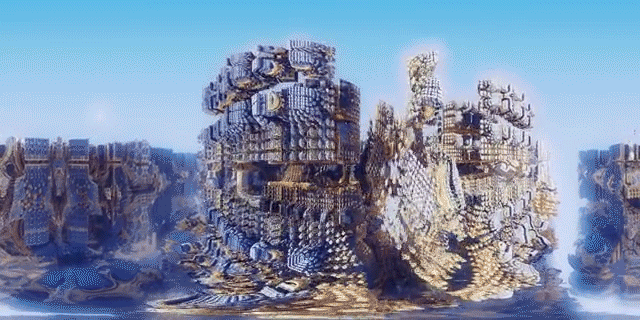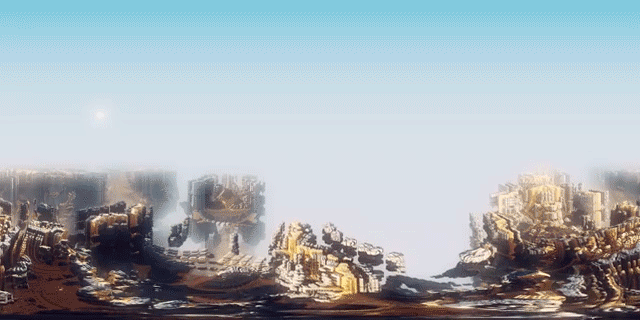How is designing a fractal world for VR different than designing a 2D video?
VR fractals, although I have only made a test animation and am now in the (very long) process of rendering a much biggger 360-degree animation, are completely different. Although the technical process is very similar, all the tricks I know as a filmmaker / animator can be thrown out the window. There’s no camera, so we have to treat it more like an architect would treat his ‘audience’. I have to do more experiments, but I think the traveling camera must be much much slower, since there’s just so much to see when looking around. I haven’t got much experience with this yet, but I’m really looking forward to be doing more of these. Since the experience is just that much more intense there is no need for ‘in your face’ stuff, and very subtle music cues paired with lighting changes can bring profound emotions in these fractal worlds.
Videos by VICE
How did the need for architecture-like design manifest in your recent test footage?
My test footage is really just that: a test. There are also mistakes in it, but it shows, I think, that we can experience the fractal world like we experience a place. Rather than having a timeline, which states this happens and then this happens, we put the viewer in a place and let them explore it by looking around. Of course, we are still bound to a timeline, because it’s not a real-time render, so we determine the pace, and what happens, but the viewer needs to feel in control of where he/she can look. The emotions may still come from revelation, not by showing something, but by literally putting the viewer into a place.

How do you use to elicit particular emotions in your animations?
The pacing and speed is important because it determines how much the viewer can see from the shapes. When does a particular pattern become boring? I try to use reduce color palettes, to give more attention to the shapes and framing. I’ve always loved cameras and lighting, so this is where I spend a lot of time. When I worked on film sets, I learned and loved the magic of lighting, of how it can transform a dull looking set (or actor) into something dramatic and fascinating, that I try to apply these same principles to the fractals. It really makes such a difference, when lit and framed cinematographically.
When determining the animation, I also try to use very simple principles as buildup, climax, etc. Sometimes I fail at this, and I think that my work has succeeded best when the pacing works. Lure the viewer in, try to make him curious about the next shape, and then reveal or transform into something unexpected.

You said that there is no need to know the math behind fractals to get started in Mandelbulb3D. Have you since learned more about that math? Do you feel there is any value to be gained artistically from learning it?
The actual math, including complex numbers, is still completely alien to me, but I have gained a feel of their effects, and can predict them up to a certain level—maybe like a surfer, who doesn’t know the very complex physics of fluid dynamics, surface tension and navier-stokes equations, but can predict very accurately what will happen.
Another example is the 4-dimensional rotation. Some fractals are in fact 4D, projected back into three dimensions. When rotated in the fourth, it seems to be morphing, but actually it’s just different bits of the 4-dimensional shape that come into view. The fourth dimension is impossible to imagine, but playing with its rotation makes is somewhat understandable.
Which artists give you insight into designing fractal worlds, particularly for VR?
I love film, and a lot of my inspiration comes from there. Worlds that are created for film inspire me, such as Christopher Nolan’s Inception and Interstellar. These films are very visual and create a strong sense of ‘presence.’ Another theme in his work is the passage of time, reverse time in Memento, dream time in Inception, relativity in Interstellar, and even though there’s no direct link from this to my work, it’s somewhere in the back of my head all the time. My recent fractal, Nothingess, was mostly based on the feeling of the multi-dimensional scene from Interstellar.
Other examples in Nolan’s work are the nested worlds in Inception—the fact that we have knowledge of the scene in the van, when we are actually in the hotel. This stuff really helps the experience of a fractal, when we’ve seen where it is in relation to something else, even if we don’t perceive it directly.
Another master at this kind of world building was Stanley Kubrick, and other inspiration comes from nature, and I’m very interested in evolutionary biology and cosmology.
What do you think your audience can gain from being able to explore a fractal world in virtual reality?
Fractals tell us something about the way the world works, and this, to me, is just incredible interesting. The idea that something seemingly complex and infinitely detailed can come from very simple beginnings is paradoxical. Either there’s something magic about math that it can do this, or—which I think is more likely—the detail and complexity is just an illusion, enhanced by the fact that our brains with which we perceive this, are made with the same fractal processes.
Visit Julius Horsthuis on Vimeo to view more of his incredible 3D fractal creations.
Related:
Take A Fractalized Trip Inside The Center Of The Earth
Fabergé Fractals Are Intangible Geometric Wonders
More
From VICE
-

MysteryVibe -

Screenshot: Shaun Cichacki -

Collage by VICE -

Collage by VICE